Learning how to make bone broth may be one of the most economical, nutritious, and wholesome foods anyone can make in their own kitchen. Rich in nutrition and deep in flavor, bone broth has benefits far beyond creating the foundation for soups, stews, & sauces.
This post may contain affiliate links at no additional cost to you. By making your purchases through the links on this website, IMSL may make a small percentage at no direct cost to you. IMSL only promotes products we use & truly believe in. Please refer to my Privacy & Disclosures for further information. IMSL thanks you for your support!
WHAT IS BONE BROTH?
Bone broth is made by simmering the bones, connective tissues, and the marrow & joints of animals for long periods of time. By doing so, you harness an immense amount of nutrients otherwise not available to consume easily from the ingredients used.
This nutrient-dense broth has been enjoyed through millennia & is now making its come-back for the health-conscious. It’s a broth known for its many health benefits. And why not? Depending on how it’s made, this rich broth provides a good source of protein (about 6 grams per cup), minerals such as calcium & phosphorus (good for bones & teeth), potassium, collagen, vitamins & amino acids, as well as magnesium (good for regulating muscle & nerve function to name a few benefits) to name just a few.
IS BONE BROTH & STOCK THE SAME?
Is bone broth and stock one and the same? Not really sure. There seem to be conflicting opinions in what the definitions of each are. Some say the only difference is the time simmered. Some claim it’s the ingredients used which determine’s the term used. Broth’s, some claim are simmered for the longer period of time 24+ hours. Some claim the opposite. Time to ask the big guns in the culinary world.
In an interview conducted by Bon Appetite with Chef Marco Canora of the brodo, a source for purchasing bone broths located in NYC, Chef Canora states the following;
“Bone broth is essentially stock,” he admits. “Three to five years ago, because of the wellness and paleo trends, stock started being called bone broth”.
Chef Marco Canora
Regardless of whether you term this healthy liquid stock or broth, one thing remains tried & true. The longer the liquid is simmered, the more nutrients & minerals can be leached from the bones.
IS BONE BROTH A NEW FANCY TREND?
Yes and no. This is one food that is considered pre-historic. Dating back, literally, to pre-historic times, this broth has been made & used traditionally throughout the world, acting as a palate cleanser, aiding digestion, and simply as a healthy drink to enjoy.
Growing up in the ’60s, rarely did you come across a pot of broth simmering on the stove. Today, with the growing popularity of eating like our ancestors, the paleo diet, and the keto diets, making bone broth a part of your daily dietary input has become popular once again. And with good reason.
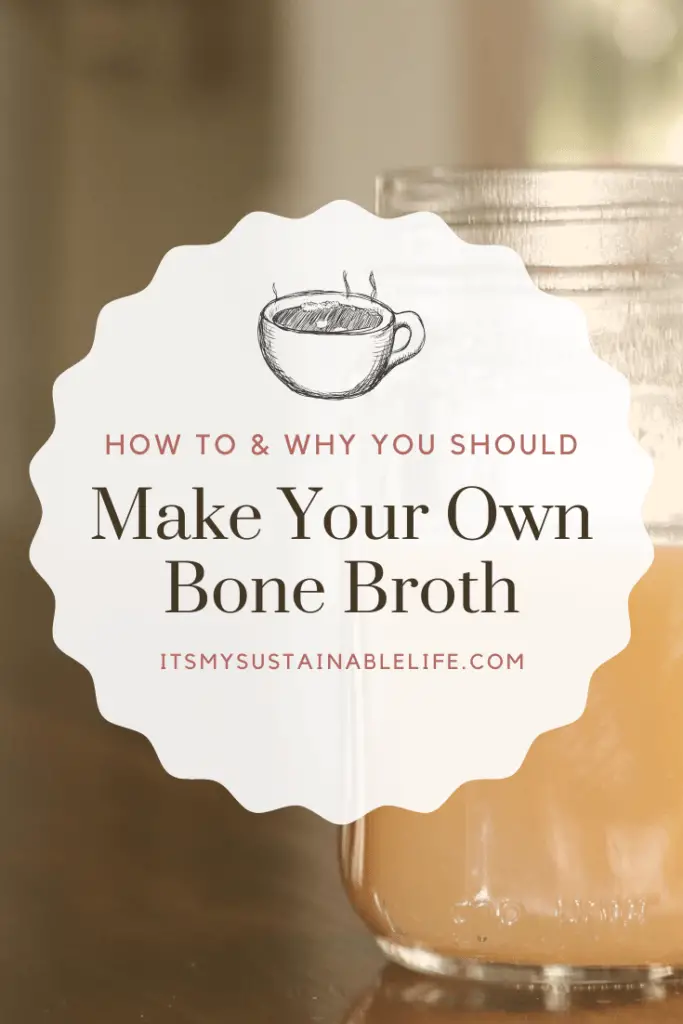
HEALTH BENEFITS OF BONE BROTH
Health benefits of drinking a cup of organic bone broth per day reach far beyond just the nutrient content. According to Sally Fallon Morell, author of “Nourishing Broth: An Old-Fashioned Remedy for the Modern World”, she states;
“It’s been known through history and across cultures that broth settles your stomach and also your nerves”. “When a recipe has that much tradition behind it, I believe the science is there too.”
Sally Fallon Morell
Ms. Fallon, author & farmer, is also a leader of the Weston Price Foundation, a foundation dedicated to Dr. Weston Price, a research pioneer “whose studies of isolated nonindustrialized peoples established the parameters of human health and determined the optimum characteristics of human diets”. We highly recommend this book so be sure to grab your copy simply by clicking the image below!
What are a few of the health benefits of utilizing bone broth in your daily diet? Here are just a few.
GUT HEALTH – Drinking a cup or more of bone broth daily can benefit a “leaky gut” as well as a healthy one. Our “guts” are comprised of over 4000 square feet of intestinal linings. The ability to absorb nutrients is largely dependent on a healthy intestinal lining. A leaky gut as explained by Marcelo Campos, MD in an article in the Harvard Health Publishing is as follows:
“An unhealthy gut lining may have large cracks or holes, allowing partially digested food, toxins, and bugs to penetrate the tissues beneath it. This may trigger inflammation and changes in the gut flora (normal bacteria) that could lead to problems within the digestive tract and beyond”.
Dr. Marcelo Campos
Ingesting the gelatin found in the feet, joints, & knuckles used in making bone broth help to “patch” these cracks or holes in the lining assist in healing many inflammatory issues found with those dealing with a “leaky gut”. Through healing these holes, diarrhea, IBS (irritable bowel syndrome), IBD (irritable bowel diseases) such as Crohn’s disease/ulcerative colitis, and even aiding in some food intolerances, may be helped from drinking bone broth.
In addition, studies have shown it to heal the mucosal lining of the digestive tracts of rats. Further research is needed to confirm this within humans.
BOOSTS IMMUNE SYSTEM – Due to bone broths’ high nutrient & mineral content, bone broth is a wonderful boost to the immune system. Broth has traditionally been used to heal, chicken soup anyone?
FIGHTS INFLAMMATION – Amino acids, specifically glycine and arginine, both have strong anti-inflammatory properties and is a “promising treatment strategy for inflammatory diseases”.
Why is inflammation in the body an issue? Inflammation is described as;
“Inflammation is the body’s response to injury, infection, disease, and exposure to chemicals. Chronic inflammation is when the bodies response hangs around long after the ailment itself is resolved. It’s chronic inflammation, aka “the silent/secret killer”, that is being linked to a wide variety of issues and diseases. Some serious conditions include but not limited to cancer, heart disease, heart attacks, Alzheimer’s, Parkinson’s, MS, diabetes and auto-immune issues.”
IMSL
IMPROVE JOINT HEALTH – Collagen, the wonder protein found in the body, is “one of the major building blocks of bones, skin, muscles, tendons, and ligaments. Collagen is also found in many other body parts, including blood vessels, corneas, and teeth”. The cooking process is what breaks down the collagen found in the bones & connective tissues and turns it into gelatin, another protein.
The natural compounds, glucosamine & chondroitin, are also found in bone broth. These compounds have been found to aid in the treatment of osteoarthritis, and joint pain.
AIDS IN WEIGHT LOSS – Typically, bone broth contains few calories but at the same time is satiating. Further, the gelatin found in bone broth has been found to assist in “maximize satiety in obese patients as a means of improving adherence to calorie-controlled diets”. Creating the feeling of “fullness”.
AIDS SLEEP – Glycine, a non-essential amino acid, has been found to aid in sleep issues and help ward off fatigue in this research study.
WHAT KIND OF BROTH IS BETTER?
In our humble opinion, the best kind of bone broth is the kind you make. In your own kitchen. From scratch. Period 🙂 As we continually say here at ISML, your food is only as good as the sourcing of it. Sourcing the best bones you can possibly find, preferably organically raised and at a minimum, grass-fed, will ensure your broth to be of the highest quality.
Can you source pre-made, purchased bone broths? As IMSL has never purchased bone broth, we cannot be a valued resource for referral when purchasing. Do your due diligence in researching the best brands, reading the labeling thoroughly. Be sure to look for ones that are made organically, from organic sourcing whenever possible with little to no added chemicals & preservatives.
When making it yourself, check with your local farmer’s markets, butchers, and farms to find a sustainable & reliable source for bones. Discuss what your intent for them is and request good marrow bones, & oxtail (soup bones) as well as feet, larger bones, & knuckles.
BEST BONES FOR MAKING BONE BROTH
In addition to the criteria outlined above, broth or stock has been made using the feet, knuckles, tendons, & joints of beef, pork, chicken, buffalo, fish, and more. Our preference is poultry, but have used all of the above except buffalo. With the addition of a few vegetables & herbs, a wonderfully, fragrant broth can be created to suit any palate. As we will continually state, sourcing is key.
We highly recommend you stick with one animal source when making a broth. You can use any animal source, but mixing the different sources in the same batch will drastically change the flavor, & in our opinion, not for the better.
BONE BROTH INGREDIENTS
To make your own broth or stock, gather your ingredients. When making bone broth here on the hill we “make it”. In other words, a LARGE quantity is made at one time. If we are running the stove & taking the time to prepare, cook, & freeze it, making it in large quantities saves us time.
The beauty of making this bone broth is there is no measuring. Simply use whatever you have on hand. There is planning, however. Over the course of several weeks or more, the scrap ends of vegetables, peels, & skins are saved and frozen. These are then used to make this broth. No time or space to save veggie scraps? Simply add an onion, a couple of carrots, or whatever veggies you love to the pot. Be sure to include the cleaned skins & peels if you have sourced from a reliable organic source!
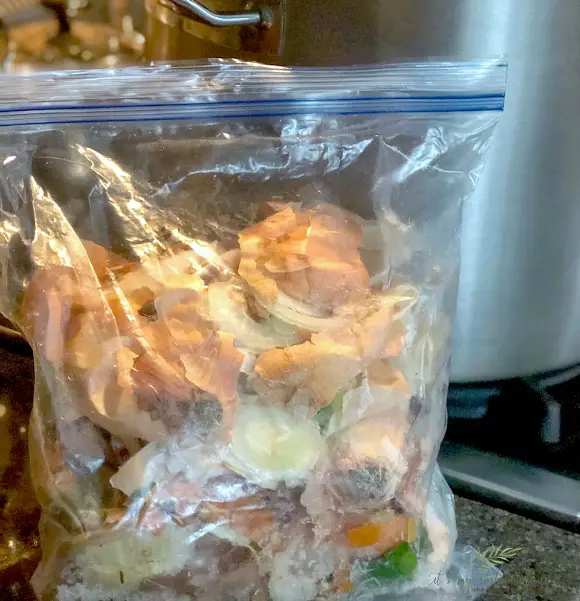
The same is done with our poultry carcasses. We save EVERYTHING leftover from either chicken soups or roasting chickens & turkeys. The carcasses, the skin, the tendons & joints, then freeze them until a large enough quantity has been saved to make our broth.
The fact that these bones are “pre-cooked” & roasted saves us the added step of roasting. Should you be using raw bones of any kind, blanching & roasting the bones prior to making the broth is a needed step.
To blanch, cover the bones with water, bring to a boil, reduce the heat and aggressively simmer for 20 minutes. To roast, simply place the bones on a baking sheet and roast well at 450 F. Roast until they are at the almost “too done” stage.
HOW TO MAKE BONE BROTH
To make your bone broth follow the steps below or skip down to the recipe card, printing if you choose.
Blanching the bones you will be using prior to roasting will aid in removing any impurities that may be present. Roast the bones of your choice along with any feet, etc, you may be using to the “almost too done stage”. As previously stated, using the poultry bones from roasting & soups, this step is skipped.
- Add the bones and all the bits and pieces, juice included to a large stockpot.
- We use a 21 quart stockpot similar to the one found HERE.
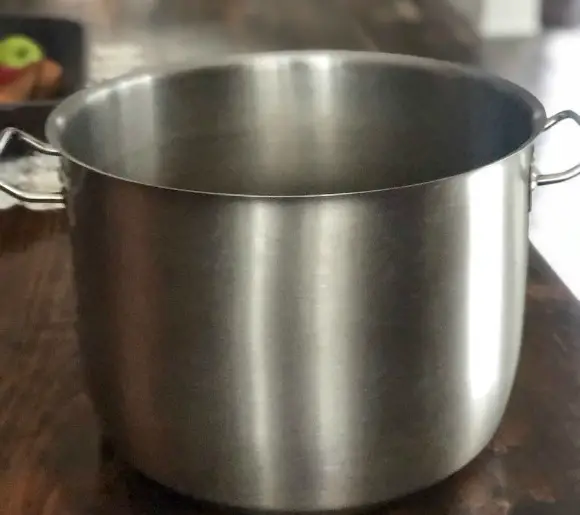
3. Add any vegetables, & garlic you wish along with the ACV. We typically use onions, carrots, celery, garlic as well as parsley and thyme. Be sure to include the ends, skins, and peels if you are able to source organically.
4. Cover all with water and bring to a boil.
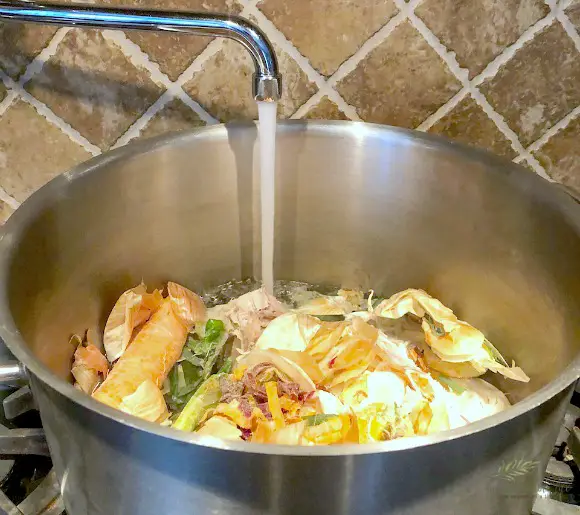
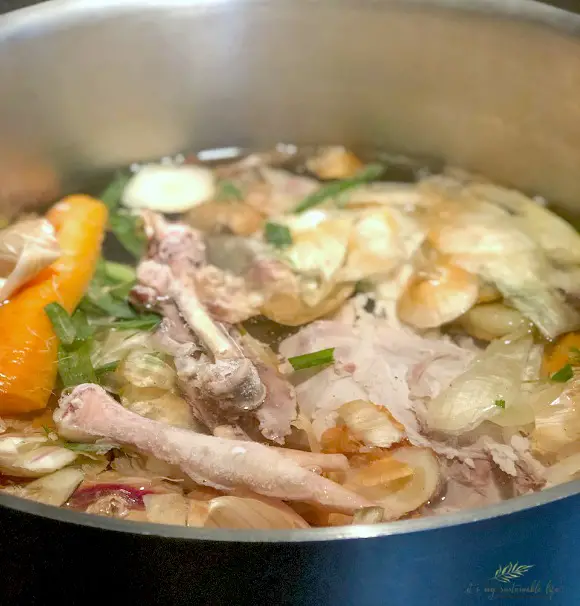
5. Reduce heat to simmer and skim off any impurities that may rise to the top.
6. Cover and simmer for 24+ hours.
7. Strain into a large container (through a colander lined with cheesecloth) and let cool.
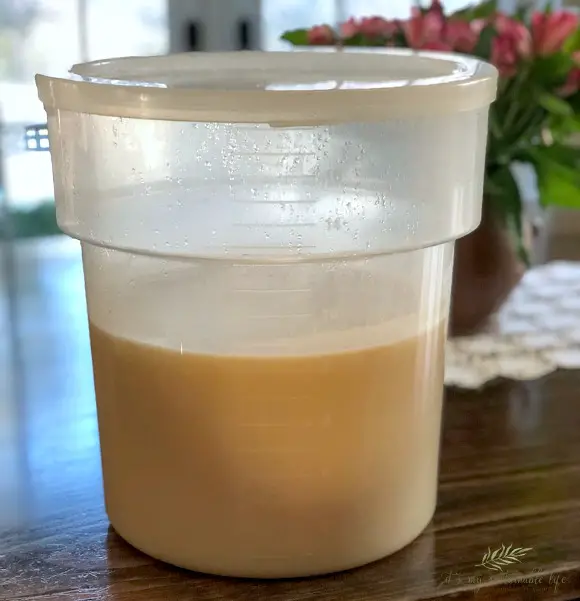
OPTIONAL HEALTHY ADDITIONS
There are no hard and fast rules about what can be added when making stock. Add what you like. Fresh herbs such as Oregano, Parsley, Thyme, & Rosemary are your favorites? Make a bouquet & add it to the broth the last hour of cooking time.
Looking to increase the efficacy of the stocks inflammation reducing properties? Add turmeric during the last 30 to 60 minutes of cooking time.
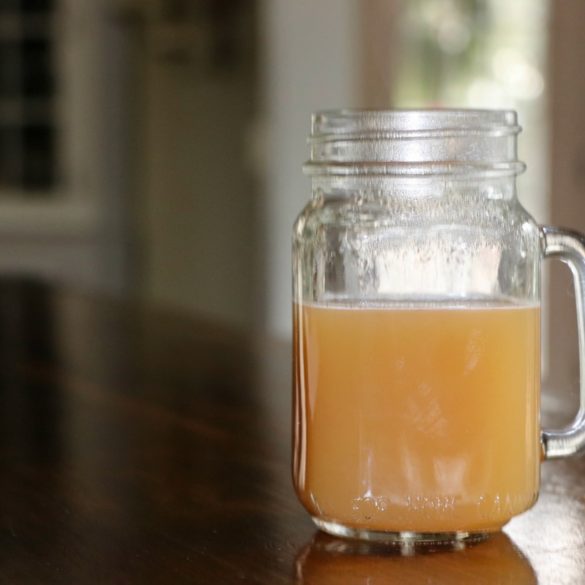
Ingredients
- Bones, Carcasses, Tissues, Tendons, & Joints
- Water
- Apple Cider Vinegar (raw or with the mother)
- Salt & Pepper
- Vegetables (along with Skins, Peels, & Ends) Suggested: Onions, Carrots, Celery
- Herbs (parsley, oregano, thyme, rosemary) of your choice
Instructions
- Blanch bones in stockpot with water just covering bones. Bring to a boil and aggressively simmer for 20 min. Drain.
- Roast bones on 450 F until well done
- Place roasted bones (along with the crispy bits & juice) into a large stockpot
- Cover with water (until just covering bones)
- Add vegetables
- Add 1-2 large cloves of garlic (smashed, skins on if organic)
- Add 1/4 Cup ACV (apple cider vinegar with the mother preferably)
- Bring to boil
- Reduce heat to simmer
- Skim off any impurities that rise to the top
- Cover and simmer for a minimum of 24+ hours
- The last hour of simmering, add herbs of choice (parsley, thyme, etc)
- Strain through a colander lined with cheesecloth and cool
- Store in refrigerator or freeze into one cup or more size quantities
Notes
Pressure Cooking Option: Cook on high for 2 hours. Reduce to the Slow Cook Function & cook for 12 hours more.
CAN YOU FREEZE BONE BROTH?
YES! Freezing is actually our preferred method of storing our prepared broth. For convenience of both drinking & cooking, we separate our broth into 1 cup quantities and freeze.
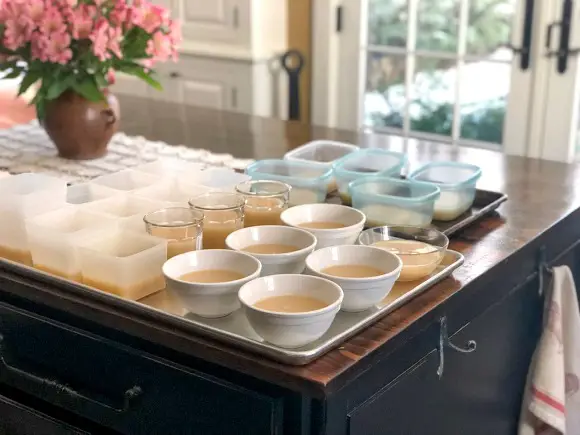
Once frozen, remove from the container and store the frozen blocks in a freezer bag until needed for recipes or drinking.
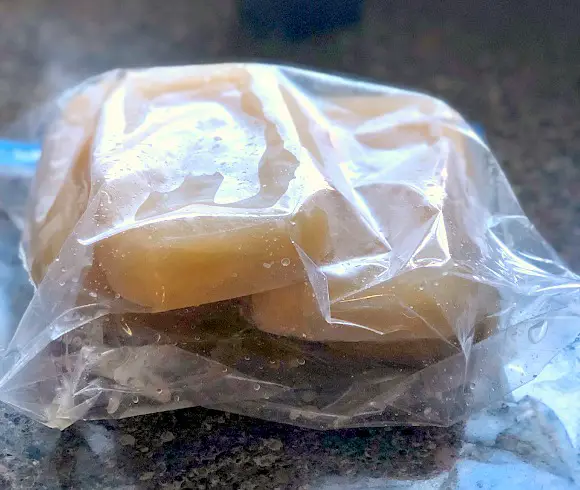
CAN YOU CAN BONE BROTH?
Absolutely! Using proper canning methods bone broth can be canned. Bone broth is considered a low acid food, thus, if you choose to can instead of freeze, you will need to use the pressure canning method. Keep your eye for an upcoming post on pressure canning methods coming soon!
IS THERE A VEGETARIAN VERSION OF BONE BROTH?
For all you vegans & vegetarians out there, sadly no, there is not a vegetarian version. The option of making a flavorful vegetable broth is always an option, however! Simply follow the guidelines above and utilize your favorite vegetables only.
The option of using raw vegetables or kicking the flavor up a bit by roasting them for a while is yours to make. Cooking time will be drastically reduced when using only vegetables, bring to a boil and simmer for 45-60 minutes only.
Storing instructions remain the same no matter what kind of broth you are making.
COMMON MISTAKES OF MAKING BONE BROTH
Although very easy to make, there are a few steps that are needed in order to create a flavorful stock. Common mistakes or steps skipped can be discouraging for the beginner broth maker.
- BLANCHING – Very rarely do you see recipes for broth encourage blanching the bones prior to roasting. This step greatly reduces any impurities and is highly recommended.
- Roasting Bones – The browning & caramelizing of the bones & tissues being used equals deep, rich flavor. Umami at it’s greatest. Don’t forget to add the crispy bits and juice to the stockpot as well 🙂
- Overdoing The Additions – Less is best in our opinion. Let the flavor of the bones shine
- Stockpot – Not using a large enough stockpot is common as is getting the ratio of water to bones right (not too diluted, water should just cover the bones, they should not be freely floating) The goal is to create a gelatinous stock
- Time – Not simmering long enough is common. This cannot be rushed. Time is needed to draw out all the nutrients & benefits of the bones
TROUBLESHOOTING BONE BROTH
By following all the recommendations and steps listed, the likelihood of issues should be greatly reduced. However, issues can still occur. Here are just a few that I have encountered over the years 🙂
Foaming. Foaming occurs when there are a large number of impurities. Making sure to blanch & roast the bones prior to simmering should reduce the amount of foaming. Simply skim off any that may remain.
Funny Taste. Did you roast the bones? Were the bones roasted long enough? Are the bones the best quality that you could find? Did you mix animal bones (using several different kinds?)
Didn’t Gel. This has occurred several times here on the hill. No worries. You still have created a highly nutritious stock. Typically, not enough connective tissues, joints, feet being used is the culprit.
HOW TO USE BONE BROTH
For us, the better question here on the hill is how to keep it available longer 🙂 The addition of bone broth to anything you make will only deepen the flavors.
Add it to gravies, soups, stews, casseroles such as shepherds pie (recipe coming soon), stuffings, risotto’s, and simply enjoy in a mug. There is no limit as to ways to enjoy this wonderful broth.
WHAT IS THE RECOMMENDED AMOUNT OF GELATIN PER DAY
The health benefits of gelatin in its natural form (not talking about jello here 🙂 ) are numerous including skin health, hair, joint health, bone health, gut health & even aid in weight loss. Bone broth is a wonderful way to reap many of gelatin’s benefits.
Gelatin is comprised of almost 98% protein, and is rich in amino-acids (organic compounds that combine to form proteins), the foundation of healthy life.
Gelatin can be overdone, however. Some side effects include “unpleasant taste, sensation of heaviness in the stomach, bloating, heartburn, and belching”. According to WebMD, when taking gelatin supplements the following guidelines should be considered,
There’s some evidence that gelatin in doses up to 10 grams daily can be safely used for up to 6 months.
Web md
Personally, we enjoy drinking bone broth on a daily basis as well as adding it to soups, stews, and casseroles, thereby getting our dose of gelatin the tasty way 🙂
HOW MUCH BONE BROTH TO DRINK PER DAY
Here on the hill, we enjoy at least 1 cup of broth a day. When we are feeling an illness coming on, we increase that to at least 2-3 cups per day.
Hopefully, this has inspired you to give making your own bone broth a try! Already make your own? Join the conversation below and let us know your process!
Love, Light, & Laughter ~


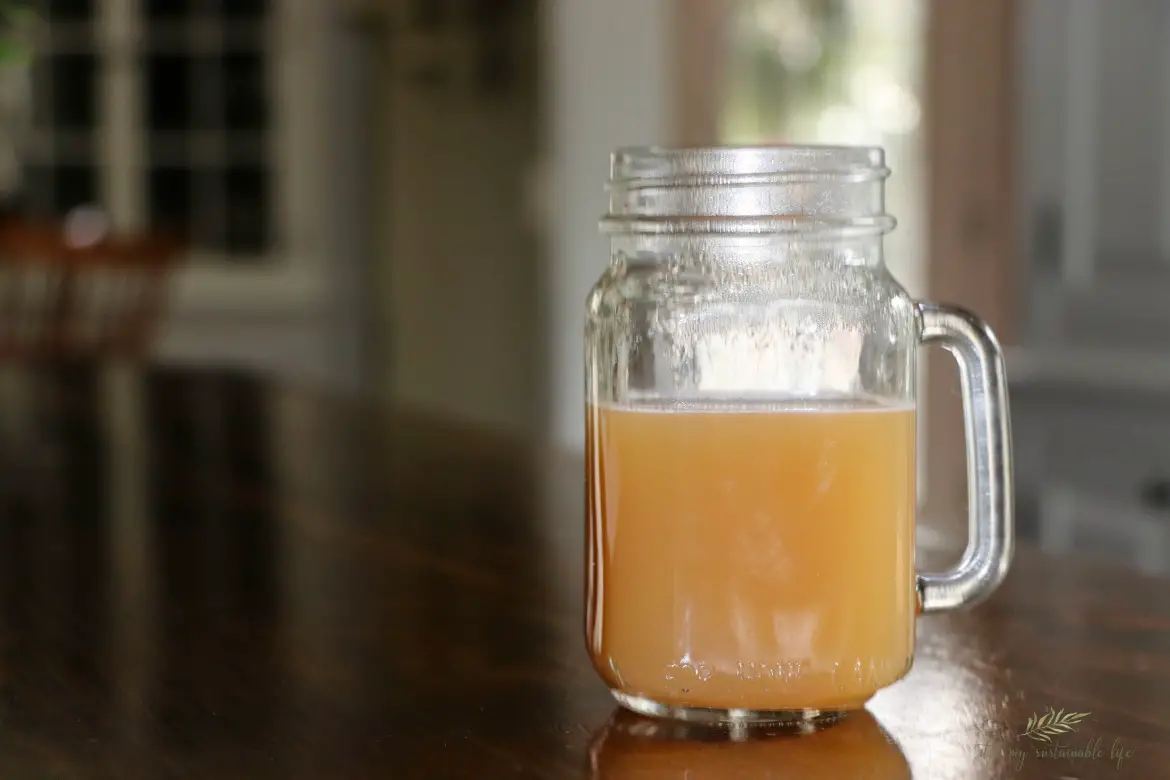
29 comments
Great in depth info as always! So many benefits of bone broth and you have shared so many tips for successfully making it. Thanks!
I am always looking for ways to improve my health and wellbeing thank you for this wonderful contribution.
Do you simmer it stovetop or crockpot for 24 hours?
Hi Peggy~
I cook mine stovetop and let it brew for a minimum of 24 hours. The same would apply to a crockpot. Instant Pot directions are easy as well. Throw your ingredients in, fill to 2/3 full with water and cook on manual low pressure for 3 hours. Hope that helps! Let me know if you have any further questions and thank you for the read!
Hi! i make bone broth often, but have never added ACV. What ratio or amount would you recommend?
Thank you!
I don’t have an exact ratio, but from what I made in this it is approximately 1/4 cup of ACV to about 8+ quarts of water give or take. Hope that scientific reply gives a little guidance, LOL! Thanks so much for reading Christine!
Thank you for sharing at #OverTheMoon. Pinned and shared. Have a lovely week. I hope to see you at next week’s party too! Happy Holiday!
This is a wonderful post! It answered a lot of my questions and made me realise that making your own bone broth isn’t as complicated as I thought it was. Thank you so much for sharing with the Hearth and Soul Link Party, Suzan. I’m featuring your post at the party this week. Happy New Year!
Thank you for reading & the feature, April! So glad you found it helpful!!
My grandparents would always do this and store it in the freezer. It just tastes better than any broth you could buy in the store and a lot less salty.
Thanks for sharing. I needed to see this. I use to drink bone broth everyday. Somehow I got out of the habit and I am not sure why. This was a great reminder of the benefits!
Thank you! I have always wanted to do this!
I have heard that bone broth was good for you, but I wasn’t sure why or how. Thanks for the info!
I love a good bone broth, and this sound amazing! Thank you for the great recipe!
I cannot be without bone broth in my house! Winter or summer it is a most and just magic!
Absolutely! I couldn’t agree with you more. Thanks so much for reading, Angela!
I’ve heard so much about this but never tried it. I do have a couple of questions:
1. Do you cook it on the stove-I’m just wondering because of the part about letting it simmer for 24+ hours.
2. How often do you drink it? I know it’s suggested every day but that seems like a lot of cooking!
Look forward to your answers. I love your blog. You always have such great articles!
Hi Cynthia~
Thank you for stopping by! In answer to your questions, yes, I cook my bone broth on the stove. I try to have it on hand to drink at least 1 cup per day. There are times when we do run out, but we try to not let that happen 🙂
I thank you for you kind words and questions! Hope you can give the broth/stock a try. Don’t hesitate to contact me if you have further questions.
this looks easy to follow! Thanks!
I can’t wait to try this! Thank you!
I was actually looking for a recipe from our Prime Rib with bones dinner from last night! This will be perfect!
This looks delicious and easy to make. With all of those nutrients, I bet you feel energized and amazing after eating this. Thank you for sharing this information.
My sister does this all the time m. So Awesome
I am going to try this. I keep hearing how healthy this is and I am trying to incorporate more things like this in my life. Thank you for sharing.
Thanks for sharing this. I have been trying to incorporate bone broth to help heal my gut issues.
We’ve done this before. It is a very handy thing to have on hand for cooking.
I love a good broth soup! And I’ve always wondered about the difference between broth and stock. Ha! This article made me feel better about switching back and forth as available.
thanks so much after all these years believe it or not I have never made my own broth but will try this and have my own on hand after this thanks for sharing.
Great tips! We love making our own bone broth, but we have never frozen it in individual servings! I love that idea.